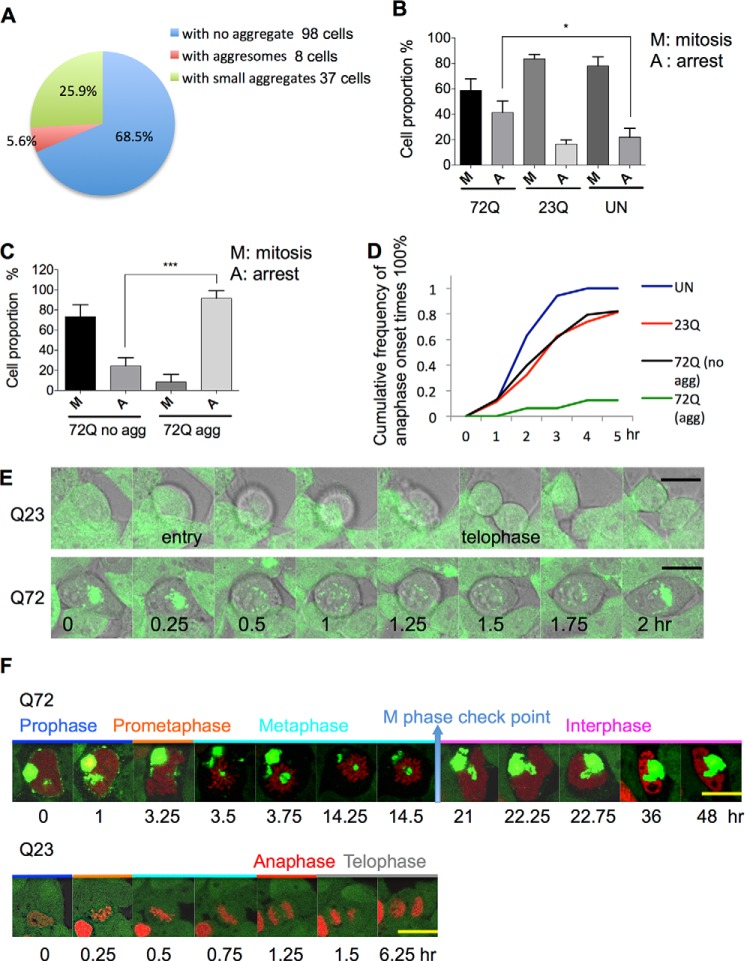FIGURE 5.
Cell cycle arrest in aggresome-containing cells. A, quantitation of mitotic cells in the EGFP-HDQ72 cell population after long term (3 months) expression of polyQ. Samples were fixed and analyzed by cell counting by confocal microscopy. As mitotic cells represent a small proportion among the whole population, ∼600 cells were assessed per experiment for three independent experiments, and 143 mitotic cells were counted in total. Mitotic cells were defined as the change of nucleus morphology if its intact structure was replaced by individual chromosomes. B, quantitation of mitotic arrest in different cell lines from time-lapse recording. Sixty percent of long term EGFP-HDQ72-expressing cells (both with and without aggresomes) successfully proceeded through mitosis, whereas 40% of them arrested. In the negative controls, 80% of cells proceeded through mitosis. Three independent experiments were performed. ∼600 cells per population per experiment were analyzed, which gave ∼40 mitotic cells assessed per population per experiment. The chart represents the mean ± S.D. Samples were analyzed by binary logistic regression. *, p < 0.05; ns, not significant. C, quantitation of mitotic arrest in long term-induced EGFP-HDQ72 cells. ∼80% of cells without aggresomes proceeded through mitosis but only 10% of aggresome-containing cells. Therefore, a large number of cells (∼600) was assessed per experiment for three independent experiments. Of all cells assessed, there were 133 mitotic cells consisting of 32 aggresome-containing cells and 101 cells without aggresomes. The chart represents the mean ± S.D. Samples were analyzed by binary logistic regression. ***, p < 0.001; ns, not significant. D, analysis of time-lapse images shows the cumulative frequency of telophase onset times. Mitotic entry was defined as detachment of the cell from the bottom of the Petri dish and spherical morphology. Telophase was defined by division into two daughter cells. Aggresome-containing cells are significantly delayed, and most of them exit mitosis after a long arrest. UN, uninduced cells; EGFP-HDQ23, long term-induced EGFP-HDQ23 cells; EGFP-HDQ72, long term-induced EGFP-HDQ72 cells with or without aggresomes. Three independent experiments were performed. ∼600 cells per population per experiment were analyzed, which gave ∼40 mitotic cells assessed per population per experiment. E, time-lapse images recorded by confocal microscopy of long term-induced EGFP-HDQ23 and EGFP-HDQ72 cells during 2 h of mitosis at 37 °C and 5% CO2. Mitosis was defined as the duration of cell detachment from the bottom of the Petri dish, with a spherical morphology. The EGFP-HDQ23 cells successfully divided into two daughter cells after 1.5 h (24/29: observed in 24 cells of 29 assessed). The aggresome-containing EGFP-HDQ72 cells arrested partway through the process and finally exited mitosis (12/14). Scale bar, 7.5 μm. The time scale and intervals are the same in both sequences. F, time-lapse images of EGFP-HDQ23 and EGFP-HDQ72 cells expressing histone-DsRed during mitosis at 37 °C and 5% CO2. Aggresomes are the large green structures, whereas nuclei and chromosomes are in red. Mitosis was defined by the duration of cell detachment from the bottom of the Petri dish, with a spherical morphology. Telophase was taken as the end of mitosis. The aggresome-containing EGFP-HDQ72 cell arrested partway in metaphase and exited mitosis after >5 h. An EGFP-HDQ23 cell is shown as a control in the lower panel. Each mitotic phase is marked by a different color and is labeled. Scale bar, 10 μm.

